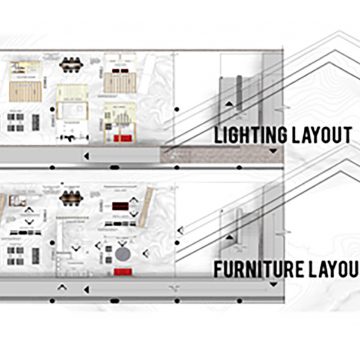The Art of Equilibrium: Just How Interior Design and Home Designer Collaborate for Stunning Outcomes
In the world of home layout, striking a balance between aesthetic appeals and capability is no tiny feat. This delicate balance is accomplished via the unified collaboration between interior developers and engineers, each bringing their unique know-how to the table. The result? Spaces that are not just aesthetically spectacular but also exceptionally comfortable. Nevertheless, this ideal mix is not always simple to achieve. Stay with us as we discover the ins and outs of this collaborative procedure and its transformative impact on home layout.
Recognizing the Core Distinctions In Between Interior Design and Home Architecture
While both interior style and home design play important duties in developing cosmetically pleasing and useful rooms, they are inherently different disciplines. It deals with the 'bones' of the framework, working with spatial dimensions, load-bearing walls, and roof designs. On the other hand, interior design is extra worried with enhancing the sensory and visual experience within that framework.
The Harmony Between Home Design and Interior Decoration
The harmony in between home style and Interior Design depends on a shared vision of design and the improvement of functional aesthetic appeals. When these two areas straighten sympathetically, they can change a living space from regular to remarkable. This cooperation calls for a deeper understanding of each technique's principles and the capability to create a natural, cosmetically pleasing setting.
Unifying Design Vision
Linking the vision for home design and Interior Design can develop a harmonious home that is both functional and cosmetically pleasing. The equilibrium starts with an integrated frame of mind; architects and indoor developers collaborate, each bringing their knowledge. This unison of concepts forms the style vision, a blueprint that guides the task. This shared vision is crucial for uniformity throughout the home, making sure a liquid shift from exterior style to indoor rooms. It promotes a collaborating approach where building elements enhance Interior Design parts and vice versa. The result is a cohesive living space that shows the home owner's taste, personality, and way of living. Therefore, unifying the design vision is vital in mixing architecture and Interior Design for sensational outcomes.
Enhancing Practical Looks
Just how does the harmony in between home design and indoor design enhance functional visual appeals? Designers lay the groundwork with their structural layout, making certain that the room is functional and effective. An architect could create a home with huge home windows and high ceilings.
Relevance of Partnership in Creating Balanced Spaces
The collaboration between indoor designers and designers is critical in developing balanced rooms. It brings harmony in between style and style, providing birth to rooms that are not only cosmetically pleasing however additionally practical. Discovering successful joint techniques can give insights right into exactly how this harmony can be efficiently attained.
Balancing Layout and Architecture
Equilibrium, a necessary facet of both indoor style and design, can only truly be achieved when these 2 areas work in harmony. This collaborative procedure results in a natural, balanced design where every component has an objective and adds to the total visual. Harmonizing layout and style is not just about developing lovely areas, but concerning crafting areas that work flawlessly for their occupants.
Successful Collaborative Approaches

Instance Studies: Effective Combination of Design and Style
Checking out a number of case research studies, it ends up being apparent how the effective integration of Interior Design and architecture can change a space. The Glass Residence in Connecticut, renowned for its minimalistic beauty, is one such instance. Designer Philip Johnson and indoor designer Mies van der Rohe teamed up to create an unified balance between the framework and the interior, leading to a smooth flow from the outside landscape to the internal living quarters. An additional exemplar is the Fallingwater Residence in Pennsylvania. Architect Frank Lloyd Wright and indoor developer Edgar Kaufmann Jr.'s collaborative initiatives lead to a strikingly one-of-a-kind house that mixes with its natural environments. These study underline the extensive influence of a successful design and style cooperation.

Getting Over Difficulties in Design and Style Partnership
Regardless of the undeniable benefits of a successful collaboration between interior design and design, it is not without its difficulties. Designers may prioritize structural stability and security, while designers focus on comfort and style. Effective communication, mutual understanding, and compromise are essential to conquer these difficulties and accomplish a successful and unified cooperation.

Future Trends: The Advancing Connection Between Home Architects and Interior Designers
As the globe of home design remains to develop, so does the partnership between advice engineers and interior designers. The pattern leans towards a much more collective and incorporated method, damaging devoid of standard roles. Architects are no much longer solely concentrated on architectural integrity, however additionally involve in enhancing aesthetic charm - Winchester architect. Alternatively, interior designers are welcoming technological aspects, influencing general design and capability. This evolving symbiosis is driven by improvements in modern technology and the expanding demand for rooms that are not just aesthetically pleasing but also useful and lasting. The future assures a more cohesive, innovative, and adaptive method to home style, as developers and designers remain to obscure the lines, promoting a connection that genuinely personifies the art of equilibrium.
Verdict
The art of equilibrium in home design is attained through the unified partnership in between interior developers and architects. In spite of challenges, this collaboration fosters development and development in layout.
While both interior layout and home architecture play important duties in creating visually pleasing and useful areas, they are inherently various disciplines.The harmony between home style and interior style lies in a shared vision of layout and the enhancement of useful appearances.Merging the vision for home architecture and indoor design can produce a harmonious living area that is both functional and cosmetically pleasing. Thus, unifying the style check vision is essential in blending style and indoor design for sensational outcomes.
Exactly how does the harmony between home style and interior style enhance useful visual appeals? (Winchester architect)